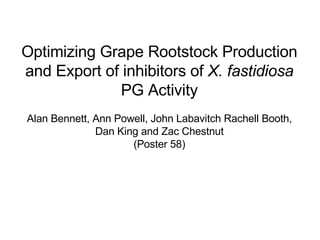
Grape Rootstock PGIP Expression for Xf Resistance
- 1. Optimizing Grape Rootstock Production and Export of inhibitors of X. fastidiosa PG Activity Alan Bennett, Ann Powell, John Labavitch Rachell Booth, Dan King and Zac Chestnut (Poster 58)
- 2. Rationale for achieving transgenic protection against Xf This project is based on observations made over the past several years by various teams in their studies of PD development in grapevines.
- 4. Caroline knocked out Xf ’s PG gene, creating a PG-less Xf . metA PG ( pglA) Conserved hypothetical MW WT PG- Tn903 kan-2 Pgforw Pgrev 1.6 kB 2.7 kB
- 5. Wild Type Xf Fetzer PG (-) Xf Fetzer H 2 O control Pathogenicity Results 18 weeks post-inoculation Without its PG, X. fastidiosa apparently does not cause PD!
- 6. PG is a pectin-degrading enzyme. Pectins are cell wall-localized polysaccharides . What aspect of PG-catalyzed cell wall degradation is important for PD development?
- 7. Pit “ membranes ” are natural filters that normally separate one vessel from neighboring vessels or living parenchyma cells. From: Taiz and Zeiger “ Plant Physiology” From: Zimmermann “Xylem Structure and the Ascent of Sap”
- 8. Pit membranes are really not membranes, they are primary cell walls and, therefore, are likely to contain: Pectins (PG substrates) and Xyloglucans (substrates for EGase) Thus, one might imagine that the roles of X. fastidiosa’s PG and EGase are to break down the pit membranes and thus allow the pathogen to spread throughout a grapevine.
- 9. Dr. Qiang Sun used monoclonal antibodies to identify some of the grapevine pit membrane polysaccharides . In fact, grapevine pit membranes do contain pectins and xyloglucan . Ca-bound pectin Xyloglucan
- 10. Pérez-Donoso and Greve introduced PG and EGase into explanted, healthy grape stems and Sun did the microscopy to show that the enzymes digested holes in pit membranes . (for more PM studies, see Sun et al. poster, #60) Pit membrane (face-on view) Control Enzyme treated
- 11. Untransformed PD Transgenic PD When PD develops on needle-inoculated control vines, symptoms are well developed in ca. 3 months. Symptom development on pear PGIP-expressing transgenics is substantially less. Controls Transgenics
- 12. Roper expressed the Xf PG in E. coli and she and Greve tested the expressed protein for PG activity. It was a PG (based on generation of reducing sugars when digesting pectin) and is inhibited by pear PGIP .
- 13. An important aspect of this proposal comes from the work of Agüero et al. (2005): They reported that the PGIP expressed in transgenic grapes that were used as rootstocks was transported across the graft junction and into non-transgenic scions via the xylem .
- 15. Given these observations, the RSAP recommended that a potentially useful strategy for improving grapevine resistance to PD would be to generate PGIP-expressing rootstocks that could mobilize enough PGIP into scions to interrupt PG-assisted systemic movement of Xf .
- 16. Objective 1 : Define a path for commercialization of a PD control strategy using PGIPs, focusing on IP and regulatory issues associated with the use of PGIPs in grape rootstocks. Objective 2 : Identify plant PGIPs that maximally inhibit X. fastidiosa PG. Objective 3 : Assemble transcription regulatory elements, Xf -inducible promoters and signal sequences that maximize PGIP expression in and transport from roots. Objective 4: Create PGIP-expressing rootstocks and evaluate their PD resistance.
- 17. Objective 1 : Define a path for commercialization of a PD control strategy using PGIPs, focusing on IP and regulatory issues associated with the use of PGIPs in grape rootstocks. PIPRA (the P ublic I ntellectual Pr operty Data base for A griculture) is led by Co-PI Alan Bennett. He and his colleagues are devising a strategy that involves the use of more readily licensed promoters, vectors etc. for use in transforming grapevines. This particular advance will be of value in grape germplasm improvement well beyond the scope of our project and problems with PD!
- 18. pPIPRA Vectors with Maximum FTO: Marker Excision Vectors For asexually propagated plants (grape, citrus) Construct allows excision of selectable markers after insertion of gene of interest (selected PGIP). For more vector information, see Bird et al. poster, #54.
- 19. 1. Selectable markers University of Tennessee, University of Kentucky 3. Constitutive and tissue Specific Promoters Univ California, Cornell Univ., AgriFood Canada, public domain 2. Recombinase system USDA and Rockefeller University System comprised of multiple patented technologies – all from PIRPA members Identification of useful promoters (Gilchrist, Lincoln et al.). For more information, see Lincoln et al. poster (56). Identification of optimized signal sequences (Dandekar et al., see Ibañez et al. poster,#42; also Gilchrist et al.).
- 21. Observed phenotype of transformed, uninoculated grapevine Other than the PGIP biochemical change and impacts on PD susceptibility of scions, we anticipate no observable phenotype. Transformed plants are to be used as rootstocks !
- 23. Comparison of challenged transgenic and non-transgenic grapevines. In our case, this means challenged scions grafted onto transgenic vs. non-TG rootstocks . Visible symptoms, Xf titers and spread from inoculation point (GFP- Xf , qPCR) Xf accumulation and localization in scions on TG vs. non-TG rootstocks as above